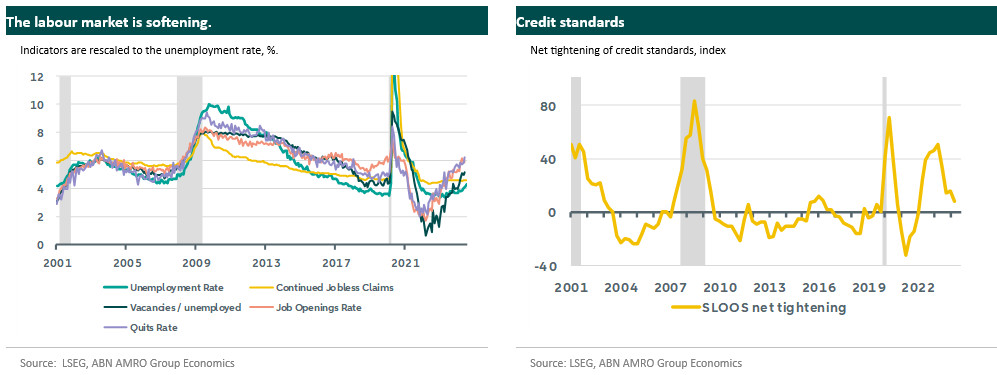US - Fasten your seatbelt, prepare for landing

The Fed is ready to start the easing cycle. The economy is still resilient, allowing for data-dependent and steady rate cuts. We therefore expect a 25bps cut in September.
The Federal Reserve stands at the onset of an easing cycle. Chair Powell announced that the ‘time has come for policy to adjust,’ widely interpreted as a pre-announcement of an initial rate cut on September 18th. The start of the easing cycle is a sign that the landing of the economy is in sight, but will it be soft or hard? Over the summer, a disappointing July jobs report led markets, amplified by an unwinding of the yen carry trade, to believe the US was in for a hard landing. Fasten your seatbelts: the S&P500 lost 7%, the VIX peaked intraday at 61 (levels only seen during the GFC and start of Covid lockdown), and market pricing of Fed rate cuts shifted from 2.9 to 4.6 rate cuts by year-end, with widespread calls for immediate intermeeting cuts. For now, markets have calmed and are pricing 100bps of cuts by year-end. We expect the Fed to cut by 25bps in September in order to catch a softening labour market, which is not so weak as to warrant a rapid easing cycle.
GDP growth in Q2 surprised to the upside at 2.8% q/q saar, on the back of solid consumption and strong domestic investment. Final sales to private domestic purchasers, an indicator of demand which strips out inventories, trade and government spending also rose by 2.6%. CPI and PCE inflation continued their downward process, with core CPI inflation coming in at 0.1% and 0.2% m/m for June and July respectively, while core PCE inflation for June came in at 0.2%. The incoming figures are generally consistent with the 2% y/y target, but base effects from the second half of last year imply that the y/y figure has a bumpy road ahead.
July unemployment figures saw the unemployment rate suddenly shoot up to 4.3%, rising by 0.6 pp since the start of the year. The swift pace of the rate’s ascent triggered the so-called 'Sahm rule', a technical rule based on moving averages. This rule suggests that if the unemployment rate rises sufficiently rapidly, a recession has started. We think this time is different. As we've argued before, the current increase in the unemployment rate is predominantly driven by above average growth in supply, while in previous episodes demand contracted. Other labour market indicators that usually move with the unemployment rate have not done so post-Covid, and have only just reached pre-Covid levels (lhs chart). Since the rise in unemployment is not as uniformly driven by a decline in demand, it is also less likely to have a strong impact on consumption and GDP growth, providing a weaker signal for a recession. Indeed, other coincident indicators paint a more benign picture. One example is the headline figure in the Senior Loan Officer Opinion Survey which has been steadily declining from its peak without a recession for the first time since its inception (rhs chart). Now, the gradual easing in lending standards suggests a strengthening in credit growth, and correspondingly subsequent investment and output growth.

To summarize, putting on your seatbelt is just common sense, even mandatory, regardless of whether you expect a soft landing. The landing will be bumpy, with volatility in monthly data releases, base effects in y/y inflation, and markets reacting strongly to incoming data. Helped by the economic tailwind, the Fed will gradually ease off the brake with inflation reaching target, growth weakening a bit, but averting a recession.
